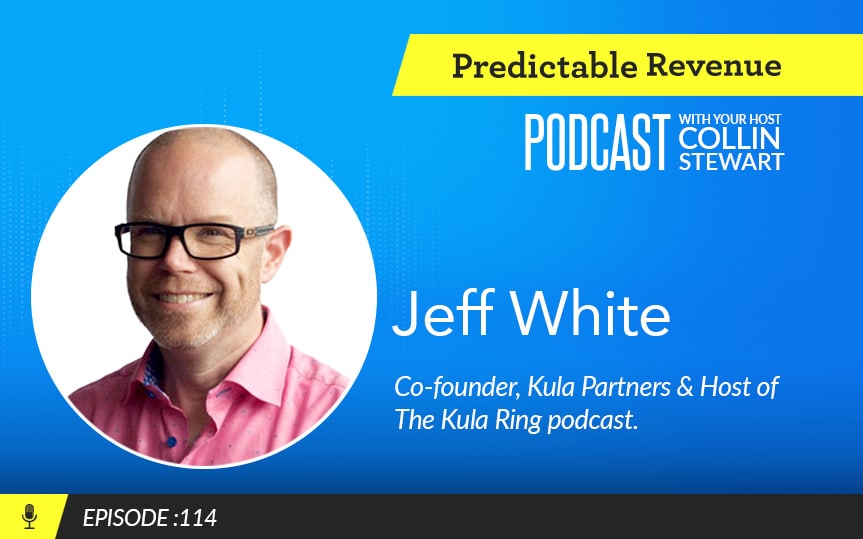Use Content to Drive Your Company’s Prospecting

Content is a tricky thing to quantify. It’s everywhere in sales – from informative blog posts, to infographics, to case studies. Yet somehow we still think of it as a separate function, this other skill…not inherently part of our work as sales professionals.
Why?
According to Jeff White, Founder, and Principal of digital agency Kula, it doesn’t have to be that way. In fact, content is the critical mechanism that connects you to prospects, builds relationships, educates your market on your offering(s), and drives opportunities and pipeline.
Content and sales, looked at this way, are one and the same. And if you’re not yet investing in it, it’s time to start.
“At the end of the day, content is all about learning and growing. We learn so much from connecting with people. Of course, your end goal is to have a sales conversation, but the altruistic goal is to learn more than you knew before,” says White, on a recent edition of The Predictable Revenue Podcast.
“One of the biggest benefits of content marketing is that you can show someone that you have been thinking about their problem for a decade. If I can show someone that I just had a conversation with a blog post I wrote in 2010 about our conversation…that is powerful.”
How Kula uses content
So…how does White and his team leverage the content it creates? How does their team turn content into leads?
First, they use content all along their outreach to prospect and book meetings. For example, White says Kula produces whitepapers, innovative assets like online calculator tools that measure the impact of their services, and a podcast. All of that content, he adds, is unique, tailored, and used to “cut through the noise.”
“I get a lot of outreach everyday. But so much of it is straight up sales requests – there is no relationship. They are just asking for the sale right away,” says White.
“When you’re selling services, having a relationship with somebody before the sales discussion is really important. Sales is based on trust. It requires building a relationship, before you go in and ask for the sale.”
Kula’s other content tactic is more subtle – they produce content for clients in manufacturing and, as a result, have a front row seat for what content resonates with that space. Moreover, they also get a window into the long and often complex sales cycles their clients face. This important knowledge bolsters Kula’s understanding of what those in the space navigate, so when they reach out to prospective clients they are able to have a nuanced discussion with them.
(Editor’s note: we had wordsmith extraordinaire and writing coach Patrick E. McLean on the show a while back to discuss how to focus your emails and avoid using jargon and any extra words in our outreach. You can read about our chat here, or listen to the whole interview here)
The power of podcasting
Of all the content options listed above, the most powerful asset and main driver of leads, White says, is the Kula Ring Podcast. Launched a little over a year ago, Kula’s podcast has been an excellent vehicle for White, and his team, to connect with marketing leaders in manufacturing (Kula’s ICP) to discuss hot topics in the space.
The process of putting together a podcast, adds White, is perfectly aligned with Kula’s content ethic: it helps build relationships, educate listeners, and, where appropriate, drive sales opportunities. That’s because, after a podcast is published, Kula’s Director of Sales, with the help of white, reviews the transcripts from each podcast to see if there were any needs discussed that Kula can help with.
Thus far, it has proven a success: for every 30 – 40 people they email to be on the pod, 5 – 6 confirm. That’s a pretty good email-to-meeting ratio.
“It’s about what the ask is: it is about lifting them up, and chatting with them about their skills,” says White.
“There are a lot of factors involved in accepting, of course – sometimes legal says no, or people in the defense industry can’t talk about it, but that’s our general response rate.”
An opportunity, it’s important to note, doesn’t arise from every podcast. Far from it, in fact. But when it does, Kula is well positioned to speak to the prospect (and former guest) in a tailored way because they have shared so much together already.
Think of the podcast as an accelerated relationship builder. It’s the beginning, in many ways, of a budding friendship. The content is the primary goal, but if there is an opportunity that comes from it later on, they jump on it.
“The podcast has been an excellent vehicle to learn, and for creating the seeds of a relationship outside of a sales environment. Admittedly, selling to a guest is tricky – and we are very new to it. But, it is showing strong signs of promise,” says White.
“There are a number of deals we’re working on that come from this outreach. We use the initial conversations about their business and see if it aligns with our business model. Those initial conversations are very helpful.”
The executive roundtable
Finally, Kula has recently started hosting remote “executive roundtables,” where they invite marketing leaders to sit down and chat with each other. It’s reminiscent of a webinar setting, but without the pressure on attendees to have to thoroughly prepare.
For each roundtable, White prepares 4 – 5 questions for the group to discuss. Again, like their podcast, this gives a Kula a chance to connect with potential prospects. But even more powerful, says White, is the connections made between the those that were invited. Often the guests don’t know each other before the meeting, but afterwards they begin to chat on their social networks and share information to help lift each other up.
“This one is really interesting. What we use the roundtables for is to find a common group of related people, all at the same level in their career. Everyone has to be at the same level of experience for it to work,” says White.
“We have done 3 of them so far. They allow people to interact with one another, and with us. They become good connections, commenting on each other’s LinkedIn posts etc. That is really great to see.”
NO TIME TO READ?
Listen On:
